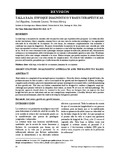| dc.rights.license | http://creativecommons.org/licenses/by-nc-sa/3.0/ve/ | |
| dc.contributor.author | Riquelme, Joel | |
| dc.contributor.author | Linares, Jeannette | |
| dc.contributor.author | Mericq, Verónica | |
| dc.date.accessioned | 2015-07-20T21:19:27Z | |
| dc.date.available | 2015-07-20T21:19:27Z | |
| dc.date.issued | 2015 | |
| dc.identifier.uri | http://www.saber.ula.ve/handle/123456789/40693 | |
| dc.description.abstract | La talla baja es un motivo de consulta cada vez más frecuente que el pediatra debe pesquisar. La evaluación debe incluir una historia clínica completa, examen físico con una correcta evaluación auxológica y un seguimiento adecuado de la velocidad de crecimiento. De esta forma, los exámenes complementarios irán orientados a confirmar una sospecha diagnóstica. En países desarrollados la mayoría de los pacientes que consulta por talla baja corresponderá a retraso constitucional del crecimiento o a una talla baja familiar, sin embargo, en alrededor de un 5% de los casos estaremos frente a patología como por ejemplo desnutrición, malabsorción, enfermedades
sistémicas y sus tratamientos, déficit de hormona de crecimiento y enfermedades genéticas entre otras. El enfoque
terapéutico, debe estar siempre orientado a la causa. Existen terapias que pueden mejorar la estatura final pero tienen indicaciones precisas y no están exentas de complicaciones. Un estilo de vida saludable y un ambiente psicosocial favorable, permitirán que el niño desarrolle al máximo su potencial genético. | es_VE |
| dc.language.iso | es | es_VE |
| dc.rights | info:eu-repo/semantics/openAccess | |
| dc.subject | Talla baja | es_VE |
| dc.subject | Velocidad de crecimiento | es_VE |
| dc.subject | Hormona de crecimiento | es_VE |
| dc.title | Talla baja: Enfoque diagnóstico y bases terapéuticas | es_VE |
| dc.title.alternative | Short stature: diagnostic approach and therapeutic basis | es_VE |
| dc.type | info:eu-repo/semantics/article | |
| dc.description.abstract1 | Short stature is a complaint of increasing frequency in pediatrics. Given the diverse etiology of growth failure, the pediatrician must be able to make a correct assessment of the growth and development of children, including a complete medical history, physical examination and a proper auxological assessment with a carefully monitoring of their growth rate. This way, any further examination shall be designed to confirm a diagnostic suspicion.
Although most patients will have an idiopathic short stature, in about 5% of cases we will find pathology. The therapeutic approach should always be oriented to the cause. There are therapies that can improve the final height but have precise indications and are not exempt from complications. A healthy lifestyle and a positive psychosocial environment, allow the child to develop his full genetic potential. | es_VE |
| dc.description.colacion | 64-77 | es_VE |
| dc.description.email | vmericq@med.uchile.cl | es_VE |
| dc.description.frecuencia | Cuatrimestral | |
| dc.publisher.pais | Venezuela | es_VE |
| dc.subject.dependencia | Sociedad Venezolana de Endocrinología y Metabolismo | es_VE |
| dc.subject.facultad | Facultad de Medicina | es_VE |
| dc.subject.institucion | Universidad de Los Andes | es_VE |
| dc.subject.keywords | Short stature | es_VE |
| dc.subject.keywords | Growth rate | es_VE |
| dc.subject.keywords | Growth hormone | es_VE |
| dc.subject.publicacionelectronica | Revista Venezolana de Endocrinología y Metabolismo | |
| dc.subject.seccion | Revista Venezolana de Endocrinología y Metabolismo: Índice Acumulado | es_VE |
| dc.subject.thematiccategory | Medicina y Salud | es_VE |
| dc.subject.tipo | Revistas | es_VE |
| dc.type.media | Texto | es_VE |


